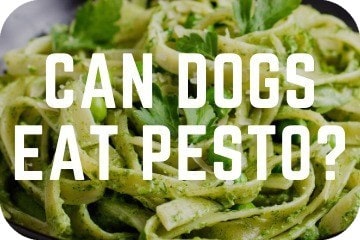
Can dogs eat pesto? No, although pesto is primarily made up of basil, which is safe for dogs, it contains garlic, which is known to be toxic. Pesto also contains oil and cheese which can cause health issues, such as, diarrhea, vomiting, and obesity.
What should I do if my dog ate pesto?
1. First, check the ingredients list. Garlic is the ingredient to look out for.
2. Determine how much was eaten and the quantity of garlic ingested.
3. Contact your veterinarian; they will be able to advise if the amount that was eaten and the size of your dog warrants the need to be seen.
4. Keep an eye out for any symptoms of anemia in your dog, if your dog is behaving differently, contact the vet or poison hotline for advice.
Signs Of Anemia:
- Light or pale gums
- Weakness
- Lethargy
- No appetite
- Lack of balance or wobbly
- Fainting
- Red urine
Busy? Get Your Hands Paws On The Answers Quickly…
- Common Ingredients And The Benefits And Risks To Dogs
- Alternative Sauces For Dogs
- Basil Dog Treat Recipes
- FAQs
COMMON INGREDIENTS AND THE BENEFITS AND RISKS TO DOGS

Can Dogs Eat Basil? Yes – SAFE
Basil is the main ingredient in pesto. It is not dangerous for dogs in small amounts and can even have nutritional benefits.
Benefits Of Basil:
- Anti-inflammatory – Basil is thought to help reduce inflammation, which can lower the risk of arthritis and heart disease.
- Contains antioxidants – The antioxidants in basil are thought to help with immunity.
- Relaxing – Basil can have a calming effect on dogs and help to prevent anxiety.
Can Dogs Eat Parmesan Cheese? Maybe – NOT RECOMMENDED
Risks Of Parmesan:
- Vomiting
- Diarrhea
- Gas
- Weight gain
- Salt poisoning
While parmesan isn’t toxic to dogs, it is high in both sodium and fat. Both are vital in dogs’ diets. However, they should already have the recommended amount of both in their regular dog food. If either is fed in excess, it can cause health problems.
If you suspect your dog has eaten a considerable amount of salt, make sure they have access to fresh, clean water. If too much salt is ingested, it can cause salt poisoning. Symptoms include extreme thirst, frequent urination, confusion, decreased appetite, seizures, and coma.
If your dog has weight issues, kidney disease, heart, or liver problems, your dog might require a lower salt diet. Therefore, parmesan is not recommended for your dog.
Parmesan also contains lactose, many dogs don’t process lactose well, which can cause gastric upset.
Can Dogs Eat Pine Nuts? Maybe – NOT RECOMMENDED
Risks Of Pine Nuts:
- High in fat – Potentially leading to weight gain, pancreatitis, and urinary tract infections.
Although not toxic to dogs, pine nuts are not recommended as they are high in fat. Foods high in fat can cause gastric upset.
If your dog consumes a considerable amount of high-fat food, it can also cause pancreatitis and urinary tract infections.
Can Dogs Eat Garlic? No – TOXIC
Garlic is a primary ingredient in pesto, and the main reason that pesto is dangerous for dogs.
How Much Garlic Is Toxic To Dogs?
According to studies shown on the American Kennel Club, it takes around 15-30g of garlic (although powder is thought to be more potent) per 1kg (or 2.2lb) of their body weight to cause harmful changes to blood or toxicity. If your dog is to eat garlic, contact a veterinarian.
Why Is Garlic Toxic?
Garlic is part of the allium family. The allium family contains n-propyl disulfide. This is toxic to dogs. If a considerable amount is consumed, it can cause anemia.
N-propyl disulfide damages the red blood cells, reducing the amount of oxygen they can carry. It can cause them to rupture. The compound tricks the cells into thinking they are invaders, destroying them, which results in anemia.
Early Signs Of Anemia Include:
- Pale gums
- Weakness
- Lethargy
- Lack of appetite
- Black stools
If you suspect your dog has eaten a dangerous amount or is showing any unusual activity, including those listed above, contact a veterinarian or poison line.
If you’re looking to learn more about the allium family and their effects on dogs, check our article ‘Can Dogs Eat Leeks‘ here.
Can Dogs Eat Lemon Juice? Maybe – NOT RECOMMENDED
Risks Of Lemon Juice:
- Gastric upset
Lemons aren’t thought to be toxic to dogs, but the citric acid can cause gastric upset and digestive issues.
Can Dogs Eat Olive Oil? Yes – SAFE (in moderation)
Benefits Of Oil:
- Improve skin and coat quality
- Contains antioxidants which can improve immunity
- Keeps their brain healthy
Risks Of Oil:
- Gastric upset
- High in fat – Potentially leading to weight gain, pancreatitis, and urinary tract infections.
Olive oil is safe and has many nutritional benefits for dogs. However, it should be fed in moderation as excess can have negative side effects. Many dogs like the taste of olive oil and a small amount can be added to their food.
ALTERNATIVE SAUCES FOR DOGS
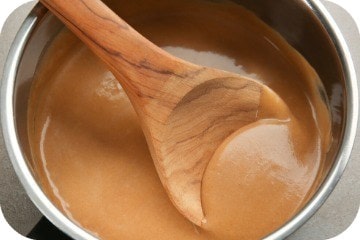
Sauces are great for topping dog food, adding to homemade treats, stuffing into KONGs, or added to lick mats.
Here is our list of sauces to use, instead of pesto:
Cottage Cheese
If your dog can tolerate lactose, then cottage cheese can be an excellent addition to their diet. It is high in both protein and calcium. If you are introducing cottage cheese, make sure to do so slowly as lactose can cause gastric upset.
Plain Yogurt
Yogurt can help your dog’s digestive system and is commonly used after an episode of diarrhea or vomiting. It is also high in protein and calcium.
Dog-Safe Applesauce
It is easy to make dog-safe applesauce with water, apple, and honey. Apples and honey both have nutritional benefits for dogs. Apples are rich in benefits and contain fiber, which is beneficial for digestion. It is a great additive to dog treats and works well for binding ingredients together.
100% Pure Peanut Butter
Peanut butter is high in protein, fat, and vitamins. It is commonly added to treats as a binding ingredient or stuffed into a KONG. Check out our article ‘Can Dogs Eat Peanut Butter‘ for more information. We also have a recipe for ‘Peanut Butter Dog Treats‘.
Dog Safe Gravy (low salt, no sweetener, no onion, no garlic, etc.)
Gravy can be made for dogs with low-sodium broths and flour. Many dog food brands also offer a gravy designed for dogs. Gravy is a great way to make food tasty for your dog. It is also a cheap additive to dog treats and can be frozen into enrichment toys.
BASIL DOG TREAT RECIPES
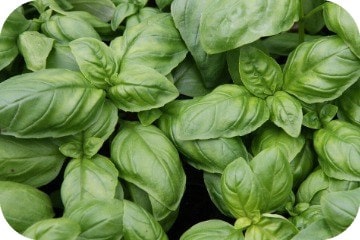
Sweet Potato and Basil Biscuits, inspired by Timid Rider
Ingredients:
- 2 1/2 cups brown rice flour
- 1 sweet potato, shredded
- 1 egg
- 1/3 cup organic coconut oil, melted
- 1 tbsp basil, finely chopped
- 1 tbsp honey
- 1/2 cup cold water
Directions:
1. Preheat your oven to 350 degrees F (176 degrees F) and line a baking sheet with parchment paper.
2. Mix all the ingredients in a large bowl.
3. Roll into small 1-inch balls and flatten with a fork.
4. Place on the baking sheet and bake for 35 minutes.
5. After baking, turn the oven off and leave cookies inside for another 30-45 minutes until crisp.
6. Allow to cool before serving.
Blueberry and Bail Bones, inspired by Key Ingredients
Ingredients:
- 1 cup blueberries
- 2 tsp water
- 1 tbsp basil, chopped
- 1 cup buckwheat flour
- 3/4 cup wheat flour
Directions:
1. Preheat the oven to 375 degrees F (190 degrees C) and line a cookie sheet with parchment paper.
2. In a food processor, blend the blueberries and water until smooth.
3. Add the basil and mix.
4. In a separate bowl, mix the flours.
5. Add the blueberry mixture to the flour and stir to form a dough.
6. Flour a clean work surface and roll the dough to 1/2-inch thick.
7. Cut into treat sized pieces, transfer to the cookie sheet, and bake for 30 minutes.
8. Allow to cool before serving.
Breath Freshening Dog Treats, inspired by The Kitchn
Ingredients:
- 1 1/2 cups whole wheat flour
- 1 1/2 cups brown rice flour
- 1/2 cup ground flax seeds
- 3 large eggs
- 1/2 cup sunflower oil
- 1/4 cup water
- 1/4 cup basil
- 7 sprigs parsley leaves, chopped fine
Directions:
1. Preheat the oven to 350 degrees F (176 degrees C) and line two cookie sheets with parchment paper.
2. In a bowl, mix the flours and flaxseed.
3. In a separate bowl, mix the remaining ingredients.
4. Combine the mixes until a dough forms.
5. Flour a clean work surface and roll the dough to 1/4-inch thick.
6. Cut into treat sized pieces, transfer to the cookie sheet, and bake for 20 minutes.
7. Turn the oven off after 20 minutes, leave in the oven to crisp for 2-12 hours.
8. Allow to cool before serving.
FAQS
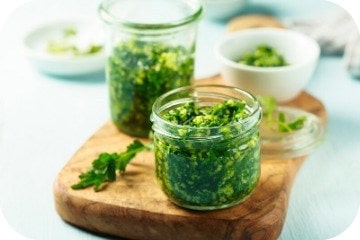
Can dogs eat pasta?
Yes, although it is not the healthiest option for dogs.
Can dogs eat gnocchi?
Yes, it is not toxic, but it is also not the healthiest option.
Can dogs eat cashews?
Maybe, but only occasionally, small amounts should be safe. Again, cashews are considered ok for dogs, but they still contain a lot of fat and may cause pancreatitis. The size also makes them choking hazards.
Can dogs eat walnuts?
Not really, they’re not likely to be toxic but are not a good snack. They’re high in fat and can cause a digestive issue. Their shape and size can also cause intestinal blockages. They also contain aflatoxin, which can be dangerous and high phosphorus levels, which can lead to bladder stones.
Can dogs eat tomatoes?
The red fruit is ok to consume (however, it still contains a small amount of toxin, but is thought to be safe is small quantities). It is a common misconception that the tomato fruit is harmful to dogs. This is not the case. However, the stem, leaves, and young green tomatoes contain solanine, which is poisonous to dogs. It is thought that a considerable amount needs to be ingested by dogs to cause toxic effects (link) (link).
Why is pesto so high in calories?
Two of the main ingredients in pesto are cheese and oil. Both of these are high-calorie food.
Looking for more pawsome posts? Check these out…
How To Make A Snuffle Mat
When Do Puppies Lose Their Teeth?
List of Human Food Dogs Can and Can’t Eat
3 Easy Homemade Dog Toys
Can Dogs Get STD’s?
Disclaimer: Each dog is different, and every circumstance is different. All efforts have been made to provide accurate information. However, it is not provided by a qualified Veterinarian, Veterinarian Surgeon, or Behaviorist. The information provided is purely educational. The information should not be used as an alternative or substitute for medical care. If you have any health or medical concerns, contact a qualified Veterinary Surgeon or Veterinarian immediately.








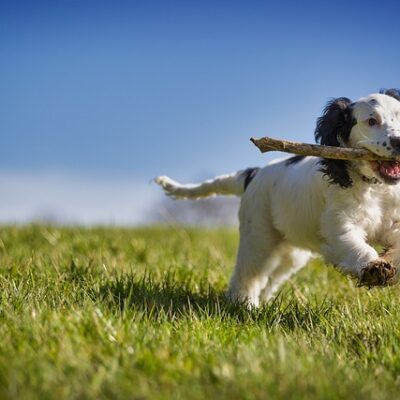
No Comment! Be the first one.